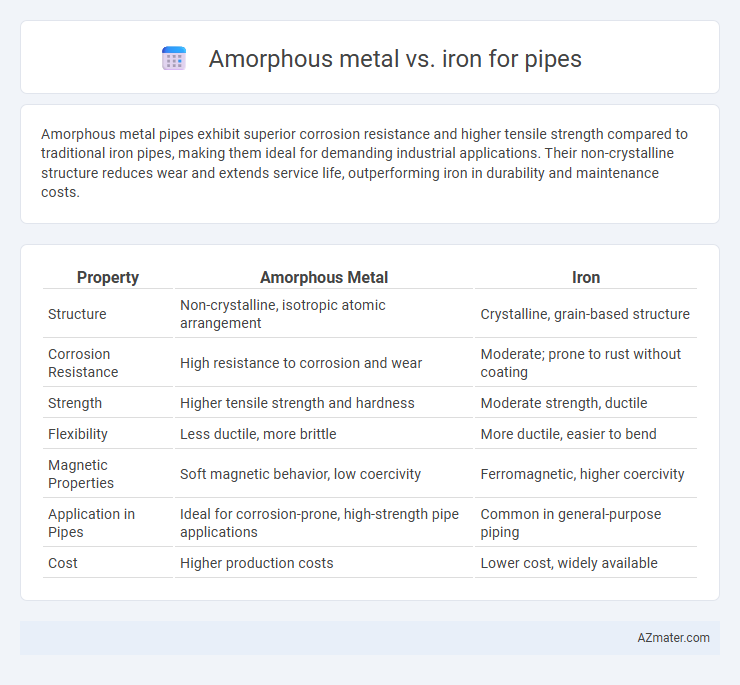Amorphous metal pipes exhibit superior corrosion resistance and higher tensile strength compared to traditional iron pipes, making them ideal for demanding industrial applications. Their non-crystalline structure reduces wear and extends service life, outperforming iron in durability and maintenance costs.
Table of Comparison
| Property | Amorphous Metal | Iron |
|---|---|---|
| Structure | Non-crystalline, isotropic atomic arrangement | Crystalline, grain-based structure |
| Corrosion Resistance | High resistance to corrosion and wear | Moderate; prone to rust without coating |
| Strength | Higher tensile strength and hardness | Moderate strength, ductile |
| Flexibility | Less ductile, more brittle | More ductile, easier to bend |
| Magnetic Properties | Soft magnetic behavior, low coercivity | Ferromagnetic, higher coercivity |
| Application in Pipes | Ideal for corrosion-prone, high-strength pipe applications | Common in general-purpose piping |
| Cost | Higher production costs | Lower cost, widely available |
Introduction to Pipe Materials: Amorphous Metals vs Iron
Amorphous metals, also known as metallic glasses, offer superior corrosion resistance and higher strength-to-weight ratios compared to traditional iron pipes, making them ideal for harsh environments and demanding applications. Iron pipes, particularly cast and ductile iron, are widely used due to their cost-effectiveness, durability, and ease of fabrication but are more prone to corrosion and scaling over time. Selecting between amorphous metal and iron pipes depends on factors such as operational conditions, required lifespan, and maintenance capabilities.
Understanding Amorphous Metals: Structure and Properties
Amorphous metals, also known as metallic glasses, have a non-crystalline atomic structure that contrasts sharply with the ordered lattice of traditional iron, giving them superior corrosion resistance and higher tensile strength. Their unique atomic arrangement eliminates grain boundaries, reducing the risk of stress corrosion cracking and enhancing durability in pipe applications. This combination of strength and corrosion resistance makes amorphous metals a promising alternative to iron for manufacturing pipes in harsh environments.
Iron Pipes: Composition, Strengths, and Applications
Iron pipes, primarily composed of cast or ductile iron, offer robust mechanical strength and excellent durability for water and gas distribution systems. Their high tensile strength, corrosion resistance through protective linings, and ability to withstand high pressure make them ideal for municipal infrastructure and industrial applications. Commonly used in potable water supply, sewage systems, and fire protection, iron pipes balance cost-effectiveness with long service life, providing reliable performance in diverse environmental conditions.
Mechanical Strength and Durability Comparison
Amorphous metals exhibit superior mechanical strength compared to traditional iron, with tensile strength often exceeding 2000 MPa, whereas iron typically ranges around 250 MPa. The unique atomic structure of amorphous metals eliminates grain boundaries, enhancing resistance to wear, fatigue, and corrosion, thereby significantly improving pipe durability. Iron pipes are more prone to rust and degradation over time, resulting in higher maintenance costs and shorter service lives than pipes made from amorphous metals.
Corrosion Resistance: Amorphous Metal vs Iron
Amorphous metals exhibit significantly higher corrosion resistance than traditional iron, due to their non-crystalline atomic structure that eliminates grain boundaries, which are common sites for corrosion in metals. This unique structure provides a uniform, dense surface that resists oxidation, chemical attack, and pitting, making amorphous metal pipes ideal for harsh environments. Iron pipes, by contrast, are more prone to rust and corrosion over time, especially when exposed to moisture and harsh chemicals, leading to reduced durability and increased maintenance costs.
Weight and Flexibility Considerations
Amorphous metal pipes are significantly lighter than traditional iron pipes, reducing overall structural load and easing installation processes. The inherent flexibility of amorphous metals allows them to absorb vibrations and accommodate minor ground movements, minimizing the risk of cracks and leaks. In contrast, iron pipes are heavier and more rigid, making them prone to fracture under stress or shifting soil conditions.
Thermal Conductivity and Heat Resistance
Amorphous metal pipes exhibit significantly lower thermal conductivity than traditional iron pipes, enhancing insulation and reducing heat loss in fluid transport systems. Their superior heat resistance allows them to withstand higher temperatures without deformation or structural failure, making them ideal for applications involving extreme thermal conditions. Iron pipes, while durable, have higher thermal conductivity and lower heat resistance, limiting their efficiency and lifespan in high-temperature environments.
Cost Analysis: Initial Investment and Lifecycle
Amorphous metal pipes typically involve a higher initial investment compared to traditional iron pipes due to advanced manufacturing processes and material costs. However, their superior corrosion resistance and durability reduce maintenance and replacement expenses, lowering the total cost of ownership across the lifecycle. Iron pipes, while cheaper upfront, often incur higher lifecycle costs because of frequent repairs, corrosion treatment, and shorter service life.
Environmental Impact and Sustainability
Amorphous metal pipes offer superior corrosion resistance and longer service life compared to traditional iron pipes, significantly reducing the frequency of replacements and associated environmental waste. Their manufacturing process typically consumes less energy and generates fewer carbon emissions due to the absence of extensive heat treatments required for iron. This enhanced durability and lower production footprint make amorphous metal pipes a more sustainable choice in water and industrial piping systems.
Choosing the Right Material: Practical Applications and Recommendations
Amorphous metal pipes offer superior corrosion resistance, high strength-to-weight ratios, and enhanced wear resistance compared to traditional iron pipes, making them ideal for harsh chemical and industrial environments. Iron pipes, while cost-effective and easier to fabricate, often require more maintenance due to susceptibility to rust and mechanical degradation in aggressive conditions. Selecting between amorphous metal and iron pipes depends on application-specific factors such as budget constraints, environmental exposure, and longevity requirements, with amorphous metals preferred for high-performance, durable infrastructure.

Infographic: Amorphous metal vs Iron for Pipe
 azmater.com
azmater.com